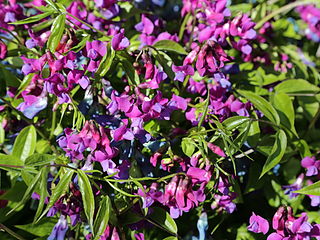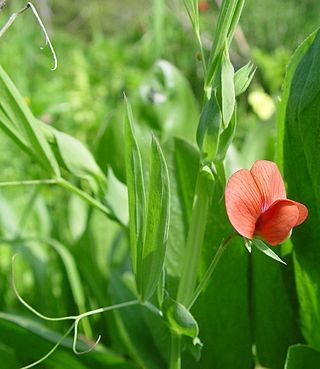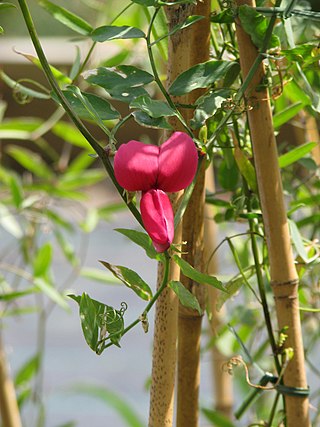
Lathyrus latifolius, the perennial peavine, perennial pea, broad-leaved everlasting-pea, or just everlasting pea, is a robust, sprawling herbaceous perennial flowering plant in the pea family Fabaceae. It is native to Europe but is present on other continents, such as North America and Australia, where it is most often seen along roadsides.

Lathyrus japonicus, the sea pea, beach pea, circumpolar pea or sea vetchling, is a species of flowering plant in the legume family Fabaceae, native to temperate coastal areas of the Northern Hemisphere, and Argentina.

Lathyrus niger, also known as black pea, blackening flat pea and black bitter vetch, is a perennial legume that is native to Europe. Its common name is reference to the blackening of the plant's foliage as it dies.

Lathyrus vernus, the spring vetchling, spring pea, or spring vetch, is a species of flowering herbaceous perennial plant in the genus Lathyrus, native to forests of Europe and Siberia. It forms a dense clump of pointed leaves with purple flowers in spring, shading to a greenish-blue with age.

Lathyrus littoralis is a species of wild pea known by the common name silky beach pea. It is native to the coastline of western North America from British Columbia to California. It is a resident of beaches and dunes.

Lathyrus angulatus is a species of wild pea known by the common name angled pea.
Lathyrus biflorus is a rare species of wild pea known by the common name twoflower pea. It is endemic to Humboldt County, California, where it is known only from the Mount Lassic Wilderness. It is a member of the serpentine soils flora. This is a petite perennial herb growing thin, tough, fuzzy stems with leaves each made up of two pairs of small linear leaflets. There are tiny bristlelike tendrils. The inflorescence bears two greenish-white pea flowers each up to a centimeter wide. The fruit is a hairless dehiscent legume pod.

Lathyrus cicera is a species of wild pea known by the common names red pea, red vetchling and flatpod peavine. It is native to Europe, North Africa, and the Middle East, and it is known from other places as an introduced species. This is a hairless annual herb producing a slightly winged stem. The leaves are each made up of two leaflike linear leaflets 3 to 6 centimeters long. They also bear branched, curling tendrils. The inflorescence holds a single pea flower 1 to 1.5 centimeters wide which is a varying shade of red. The fruit is a hairless dehiscent legume pod.

Lathyrus delnorticus is an uncommon species of wild pea known by the common name Del Norte pea. It is native to the Klamath Mountains of southern Oregon and northern California, where it is a member of the serpentine soils flora. This is a hairless perennial herb producing a winged or flanged stem. The leaves are made up of several pairs of oval or lance-shaped leaflets and the stipules of the leaves are wide and toothed. There are branching, coiled tendrils. The plant bears a dense inflorescence of up to 10 pea lavender-veined white flowers each up to 1.5 centimeters wide. The fruit is a hairless dehiscent legume pod.

Lathyrus hirsutus is a species of wild pea known by several common names, including Caley pea, singletary pea, hairy vetchling, and Austrian winter pea. It is native to Europe, North Africa, and much of Asia, and it is known from other continents, including North America, as an introduced species. This is an annual herb producing a winged stem and leaves each made up of two leaflike leaflets with a branching, coiled tendril. The inflorescence holds one or two pink, blue, or bicolored pea flowers each 1 to 1.5 centimeters wide. The fruit is a dehiscent legume pod covered in hairs with each hair growing from a minute bulbous base. The rest of the plant is generally hairless.
Lathyrus jepsonii is a species of wild pea known by the common names delta tule pea and Jepson's pea. It is endemic to California, where it grows in a number of habitat types, including forest and estuary.

Lathyrus palustris is a species of wild pea known by the common name marsh pea. It is native to Europe, Asia, and North America. It is a perennial herb with leaves made up of oval-shaped or oblong leaflets a few centimeters long. It has branched, coiled tendrils. The plant bears an inflorescence of two to eight pinkish purple pea flowers each up to two centimeters wide. The fruit is a dehiscent legume pod.

Lathyrus polyphyllus is a species of wild pea known by the common name leafy pea. It is native to the western United States from Washington to northern California, where it grows in forest and other habitat. This is a perennial herb with long leaves each made up of many pairs of oval-shaped leaflets a few centimeters long. The leaf also has tendrils which may be long, branched and coiled, or just a short bristle. The stipules are large as well, often over a centimeter wide. The plant produces an inflorescence of up to 12 pea flowers usually arranged in a line along one side of the stem. The flowers are up to 2 centimeters wide and are a variety of shades of purple. The fruit is a dehiscent legume pod containing peas.

Lathyrus splendens is a species of wild pea known by the common names pride of California and Campo pea. It is native to Baja California and its range extends into San Diego County, California, where it grows in the chaparral. This is a climbing perennial pea vine with coiling tendrils. Its leaves are each made up of 6 to 8 linear to oval-shaped leaflets a few centimeters long and wavy-margined stipules. The plant produces showy inflorescences of up to 6 bright to deep red flowers each about 3 centimeters wide. The fruit is a hairless dehiscent legume pod.

Lathyrus tingitanus is a species of wild pea known by the common name Tangier pea. It is native to southwestern Europe and Northwest Africa, and it is present in other regions of the world as an introduced species, including the Pacific Northwest of the United States. This is an annual herb producing a winged stem which climbs by means of coiled tendrils. The leaves are each made up of two leaflike linear leaflets a few centimeters long. The inflorescence has two or three pea flowers in varying shades of red, each up to 3 centimetres (1.2 in) wide. The fruit is a hairless dehiscent legume pod.

Lathyrus vestitus is a species of wild pea known by the common name Pacific pea. It is native to western North America, where it is mostly found in the forests, woodlands, and chaparral of California. The ranges of some subspecies extend into Oregon and Baja California. This is a perennial pea vine which varies in appearance across subspecies. Leaves are made up of several leaflets of various shapes up to 4 or 5 centimeters long. The leaves usually bear coiling tendrils and the stipules may be large or small. The inflorescence is a showy array of up to 15 pea flowers, sometimes densely packed together, and usually some shade of bright violet, light to medium purple, or white.

Lathyrus rigidus is a species of wild pea known by the common name stiff pea. It is native to the Modoc Plateau and surrounding areas in the western United States from northeastern California to Idaho. It is a plant of the sagebrush scrub and other habitat in the region. This is a perennial herb forming a clump of short, erect stems. The leaves are made up of several pairs of leaflets 1 to 3 centimeters long each. The inflorescence is a dense raceme of two to five white or pink pea flowers, each roughly 2 cm (0.8 in) long. The fruit is a hairless legume pod.

Lathyrus sphaericus is a species of wild pea known by the common names grass pea and round-seeded vetchling. It is native to Eurasia and much of Africa, and it is known on other continents as an introduced species. It can grow in many types of habitat, including disturbed areas. This is an annual herb producing a slender stem and bearing leaves each made up of two long, narrow, grasslike leaflets up to 6 centimeters long and a coiling, climbing tendril. The inflorescence is made up of one pea flower on a stalk one or two centimeters long ending a in a bristle. The flower is roughly a centimeter long and deep orange-red or dull red in color. The fruit is a hairless legume pod marked with longitudinal stripes.

Lathyrus linifolius is a species of pea, commonly called bitter vetch or heath pea. The name bitter vetch is also sometimes used for Vicia ervilia and also for Vicia orobus. The tubers of Lathyrus linifolius were formerly used as an appetite suppressant in medieval Scotland, and this use has brought the plant to recent medical attention. Attempts are being made to cultivate the plant on a commercial scale.
Lathyrus lanszwertii var. bijugatus is a variety of flowering plant in the family Fabaceae known by the common names drypark pea, pinewoods sweetpea, and Latah tule-pea. It is native to western North America from British Columbia to Oregon to Montana, and possibly as far south as California.

















